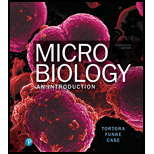
Microbiology: An Introduction (13th Edition)
13th Edition
ISBN: 9780134605180
Author: Gerard J. Tortora, Berdell R. Funke, Christine L. Case, Derek Weber, Warner Bair
Publisher: PEARSON
expand_more
expand_more
format_list_bulleted
Concept explainers
Question
Chapter 2, Problem 4MCQ
Summary Introduction
Introduction:
Acidithiobacilus ferrooxidans is a gram negative proteobactrium, which grows under high temperature (30oC) and very low pH (pH 1-2). It is present in natural abundantly and associated with pyritic ore bodies, coal deposits and acidified drainages. A. ferroxidans is the few rare bacterium which gain energy by oxidation of ferrous ion and reduced sulfur compounds. Bioleaching or biohydrometallurgy is one of its industrial application.
Expert Solution & Answer
Want to see the full answer?
Check out a sample textbook solution
Students have asked these similar questions
What is the structure and function of Eukaryotic cells, including their organelles? How are Eukaryotic cells different than Prokaryotic cells, in terms of evolution which form of the cell might have came first? How do Eukaryotic cells become malignant (cancerous)?
What are the roles of DNA and proteins inside of the cell? What are the building blocks or molecular components of the DNA and proteins? How are proteins produced within the cell? What connection is there between DNA, proteins, and the cell cycle? What is the relationship between DNA, proteins, and Cancer?
Why cells go through various types of cell division and how eukaryotic cells control cell growth through the cell cycle control system?
Chapter 2 Solutions
Microbiology: An Introduction (13th Edition)
Ch. 2 - What is a chemical element?Ch. 2 - DRAW IT Diagram the electronic configuration of a...Ch. 2 - What type of bond holds the following atoms...Ch. 2 - Classify the following types of chemical...Ch. 2 - Bacteria use the enzyme urease to obtain nitrogen...Ch. 2 - Classify the following as subunits of either a...Ch. 2 - DRAW IT The artificial sweetener aspartame, or...Ch. 2 - DRAW IT The following diagram shows the...Ch. 2 - Prob. 9RCh. 2 - Prob. 10R
Ch. 2 - Assume E. coli bacteria are grown in a nutrient...Ch. 2 - If Pseudomonas bacteria are supplied with...Ch. 2 - If E. coli were grown in a medium containing the...Ch. 2 - Prob. 4MCQCh. 2 - Prob. 5MCQCh. 2 - Prob. 6MCQCh. 2 - The dissociation products of the molecules are...Ch. 2 - Prob. 8MCQCh. 2 - The dissociation products of the molecules are...Ch. 2 - Prob. 10MCQCh. 2 - When you blow bubbles into a glass of water, the...Ch. 2 - Prob. 2ACh. 2 - Prob. 3ACh. 2 - Prob. 4ACh. 2 - Prob. 1CAECh. 2 - Prob. 2CAECh. 2 - Newborn babies are tested for phenylketonuria...Ch. 2 - The antibiotic amphotericin B causes leaks in...Ch. 2 - Prob. 5CAE
Knowledge Booster
Learn more about
Need a deep-dive on the concept behind this application? Look no further. Learn more about this topic, biology and related others by exploring similar questions and additional content below.Similar questions
- In one paragraph show how atoms and they're structure are related to the structure of dna and proteins. Talk about what atoms are. what they're made of, why chemical bonding is important to DNA?arrow_forwardWhat are the structure and properties of atoms and chemical bonds (especially how they relate to DNA and proteins).arrow_forwardThe Sentinel Cell: Nature’s Answer to Cancer?arrow_forward
- Molecular Biology Question You are working to characterize a novel protein in mice. Analysis shows that high levels of the primary transcript that codes for this protein are found in tissue from the brain, muscle, liver, and pancreas. However, an antibody that recognizes the C-terminal portion of the protein indicates that the protein is present in brain, muscle, and liver, but not in the pancreas. What is the most likely explanation for this result?arrow_forwardMolecular Biology Explain/discuss how “slow stop” and “quick/fast stop” mutants wereused to identify different protein involved in DNA replication in E. coli.arrow_forwardMolecular Biology Question A gene that codes for a protein was removed from a eukaryotic cell and inserted into a prokaryotic cell. Although the gene was successfully transcribed and translated, it produced a different protein than it produced in the eukaryotic cell. What is the most likely explanation?arrow_forward
- Molecular Biology LIST three characteristics of origins of replicationarrow_forwardMolecular Biology Question Please help. Thank you For E coli DNA polymerase III, give the structure and function of the b-clamp sub-complex. Describe how the structure of this sub-complex is important for it’s function.arrow_forwardMolecular Biology LIST three characteristics of DNA Polymerasesarrow_forward
arrow_back_ios
SEE MORE QUESTIONS
arrow_forward_ios
Recommended textbooks for you
 Cardiopulmonary Anatomy & PhysiologyBiologyISBN:9781337794909Author:Des Jardins, Terry.Publisher:Cengage Learning,
Cardiopulmonary Anatomy & PhysiologyBiologyISBN:9781337794909Author:Des Jardins, Terry.Publisher:Cengage Learning,- Essentials of Pharmacology for Health ProfessionsNursingISBN:9781305441620Author:WOODROWPublisher:Cengage

Cardiopulmonary Anatomy & Physiology
Biology
ISBN:9781337794909
Author:Des Jardins, Terry.
Publisher:Cengage Learning,




Essentials of Pharmacology for Health Professions
Nursing
ISBN:9781305441620
Author:WOODROW
Publisher:Cengage
